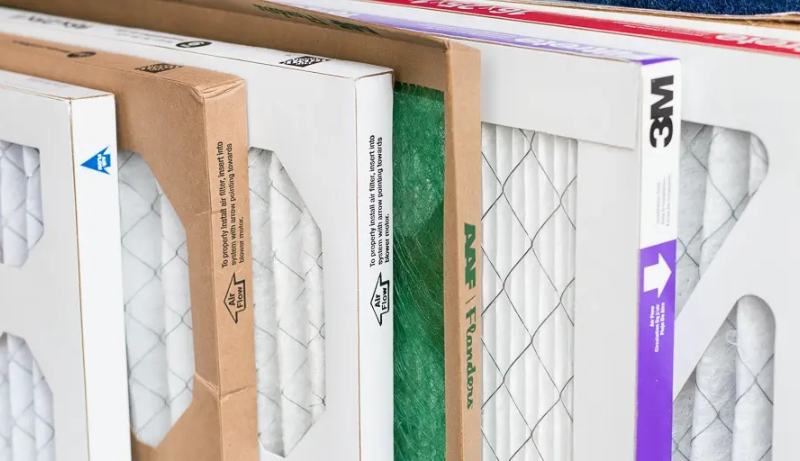If you own a furnace, the routine task of replacing furnace filters probably sounds familiar. Typically, these filters require replacement every 2 to 6 months, depending on various factors. Furnace filters come in a range of sizes, including 1 inch, 2 inches, 4 inches, and thicker variants, all designed to fit your furnace. But are they all equally effective? This article delves into the comparison between 4-inch and 1-inch furnace filters to help you make an informed decision.
Why Compare 4 Inch vs. 1 Inch Furnace Filters?
While the standard dimensions (length and width) of a furnace filter do not significantly affect its efficiency, the thickness plays a pivotal role. Therefore, we’ll focus on comparing 1-inch and 4-inch furnace filters, or more broadly, thin filters versus thick ones.
One might contemplate replacing a 4-inch filter with a thinner 1-inch alternative to reduce replacement costs. However, will this switch work effectively, or will it negatively impact the furnace’s performance? Let’s explore the nuances of this comparison.
1 Inch vs. 4 Inch Filters for Furnace: Head to Head
1. Static Pressure
When comparing two filters with the same MERV rating, the primary difference lies in the “Furnace Filter Static Pressure” on the system. A 4-inch filter boasts more surface area and consequently more holes for air to pass through, making it less restrictive. Conversely, a 1-inch filter is more restrictive, creating higher air pressure, resulting in static negative pressure in the system.
This static pressure can put more strain on the blower motor of your furnace, potentially decreasing its lifespan. In contrast, a 4-inch filter is gentler on the motor, which can extend its longevity.
2. System Efficiency
The thickness of the filter significantly affects furnace efficiency. When comparing 1-inch and 4-inch filters with the same MERV rating, the impact on efficiency becomes evident.
If you pass the same amount of dirty air through both filters, the 4-inch filter will have more “unclogged” pores, allowing for better airflow. Before becoming saturated, the 1-inch filter will facilitate more airflow (CFM), which ultimately impacts the efficiency of the furnace. The thicker filter maintains higher efficiency for a longer period, while the efficiency of the thinner filter declines more rapidly.
3. Furnace Filter Change Interval
The frequency of filter replacement is another crucial consideration. Generally, thinner filters require less frequent replacement. However, three factors influence this replacement frequency:
- The filter’s capacity to hold dirt particles.
- The airflow (CFM) through the system.
- The amount of dirt in a given amount of air.
While the second and third factors are independent of filter size and type, the first factor is closely related to filter dimensions. Specifically, thickness plays a significant role in determining the filter’s surface area. For instance, a thicker filter, such as a 4-inch one, can accommodate more pleats, increasing the surface area available to trap dirt.
MERV Rating Range: 1 Inch vs. 4 Inch Furnace Filters
Both 1-inch and 4-inch furnace filters are available in a range of MERV (Minimum Efficiency Reporting Value) options, which directly impact the indoor air quality. Let’s explore the MERV ratings each type supports and the contaminants they can effectively filter:
- 1-inch furnace filter:
- MERV Range: 1 to 13
- Contaminants: Pollen, cockroach debris, spray paint dust, dust mites, dust mite debris, carpet fibers, sanding dust, textile fibers, mold spores, hair spray, cat and dog dander, dusting aids, fabric protector, pudding mix, legionella, lead dust, humidifier dust, auto emission particulates, milled flour, nebulizer droplets.
- Additional Contaminants (for higher MERV ratings): Bacteria, some viruses, cooking oil, most smoke and insecticide dust, droplet nuclei (sneeze), most paint pigments, most face powder.
- 4-inch furnace filter:
- MERV Range: 8 to 16
- Contaminants: Most of the contaminants covered by 1-13 MERV ratings.
- Additional Contaminants (for higher MERV ratings): Bacteria, some viruses, cooking oil, most smoke and insecticide dust, droplet nuclei (sneeze), most paint pigments.
What Can We Learn from the Chart?
Firstly, 4-inch filters offer a broader range of MERV ratings, with some overlap with 1-inch filters. A 4-inch filter will provide at least an 8 MERV rating, and you can go up to 16, allowing you to filter out super-micro contaminants like bacteria, viruses, and powdery particles.
On the other hand, 1-inch filters are effective for removing typical dust, pet dander, and particles up to 3 microns in size.
At this point, there isn’t a clear winner; your choice depends largely on your air cleaning preferences and specific needs.
Cost Considerations
When it comes to furnace filters, the cost can be divided into two categories:
1. Purchase/Renewal Cost
- 4-inch filters: These filters typically have a higher upfront cost, ranging from $20 to $30 per unit. Here are some recommended options:
- Budget pick: Nordic Pure 20x25x4 (MERV 12)
- Best of both worlds: Honeywell FC100A1037 (MERV 11)
- Best high-end: Nordic Pure 20x20x4 (MERV 13)
- 1-inch filters: In contrast, 1-inch filters are more budget-friendly, with prices typically ranging from $5 to $15 per unit. Here are some recommended options:
- Budget pick: FilterBuy AFB Silver (MERV 8)
- Best of both worlds: AIRx ALLERGY 16x20x1 (MERV 11)
- Best high-end: Filtrete 16x20x1 (MERV 11) or AIRx HEALTH 20x25x1 (MERV 13)
2. Energy Bills
Furnace filters themselves do not consume electricity, but they play a passive role in your monthly energy bill. When both 4-inch and 1-inch filters are in a new and clean condition, and the airflow (CFM) through the system is optimal, they won’t significantly impact your energy consumption. However, as they become clogged over time, the furnace motor must work harder.
A 4-inch clogged filter can place more stress on the motor compared to a 1-inch filter. Neglecting to clean or replace it can lead to increased energy consumption and potentially higher energy costs.
In conclusion, while 4-inch filters may have a higher initial cost, they offer better filtration and longer replacement intervals, potentially offsetting the expense. On the other hand, 1-inch filters are budget-friendly but require more frequent replacements. Your choice should align with your specific air cleaning needs, budget, and willingness to balance upfront costs against long-term efficiency and maintenance considerations.
Frequently Asked Questions (FAQ)
Can I use a 1-inch filter instead of a 4-inch filter?
- Yes, you can use a 1-inch filter as an alternative to a 4-inch filter if you are comfortable with more frequent replacements and understand that it may place a bit more stress on the system. This can be a budget-friendly option.
Is a 4-inch or 1-inch furnace filter better for filtration efficiency?
- In terms of durability and filtration efficiency, 4-inch filters are superior to 1-inch filters.
How often should I change furnace filters of both 1-inch and 4-inch sizes?
- For thinner filters like 1-inch or 2-inch versions, you might need to change them every 1-2 months. Thicker filters, such as 4-inch or 5-inch varieties, typically have a longer replacement interval of 6-12 months.
Bottom Line
In the world of furnace filters, size does matter, particularly when it comes to filter thickness. While 1-inch furnace filters may save you a few bucks upfront, 4-inch or thicker filters offer the best value for your investment. Additionally, they contribute to better health and efficiency for your furnace system, making them the ultimate choice in the long run.




Leave a Reply